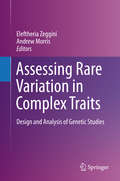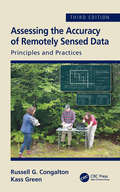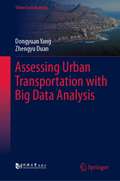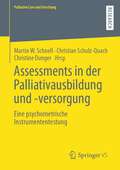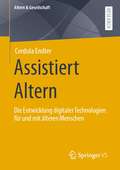- Table View
- List View
Assessing Rare Variation in Complex Traits: Design and Analysis of Genetic Studies
by Eleftheria Zeggini Andrew MorrisThis book is unique in covering a wide range of design and analysis issues in genetic studies of rare variants, taking advantage of collaboration of the editors with many experts in the field through large-scale international consortia including the UK10K Project, GO-T2D and T2D-GENES. Chapters provide details of state-of-the-art methodology for rare variant detection and calling, imputation and analysis in samples of unrelated individuals and families. The book also covers analytical issues associated with the study of rare variants, such as the impact of fine-scale population structure, and with combining information on rare variants across studies in a meta-analysis framework.Genetic association studies have in the last few years substantially enhanced our understanding of factors underlying traits of high medical importance, such as body mass index, lipid levels, blood pressure and many others. There is growing empirical evidence that low-frequency and rare variants play an important role in complex human phenotypes. This book covers multiple aspects of study design, analysis and interpretation for complex trait studies focusing on rare sequence variation. In many areas of genomic research, including complex trait association studies, technology is in danger of outstripping our capacity to analyse and interpret the vast amounts of data generated. The field of statistical genetics in the whole-genome sequencing era is still in its infancy, but powerful methods to analyse the aggregation of low-frequency and rare variants are now starting to emerge.The chapter Functional Annotation of Rare Genetic Variants is available open access under a Creative Commons Attribution 4.0 International License via link.springer.com.
Assessing the Accuracy of Remotely Sensed Data: Principles and Practices, Third Edition
by Russell G. Congalton Kass GreenThe past 10 years have brought amazing changes to the technologies used to turn remotely sensed data into maps. As a result, the principles and practices necessary for assessing the accuracy of those maps have also evolved and matured. This third edition of Assessing the Accuracy of Remotely Sensed Data: Principles and Practices is thoroughly updated and includes five new chapters. Now 15 chapters long, this text is the only one of its kind to provide geospatial analysts with the requisite considerations, tools, and theory necessary to conduct successful and efficient map accuracy assessments; and map users with the knowledge to fully understand the assessment process to ensure effective use of maps. See What’s New in the Third Edition: All original chapters have been updated to include new standards, practices, and methodologies. A new chapter on planning accuracy assessments. A new chapter on assessing maps created using object-based technologies. Two case study chapters - one showcasing the assessment of maps created from traditional methods, and one on the assessment of object-based maps. Emphasis on considering and planning for positional accuracy in concert with thematic accuracy. An appendix containing the internationally recognized ASPRS Positional Accuracy Standards. A new final chapter summarizing the key concepts, considerations and lessons learned by the authors in their decades of implementing and evaluating accuracy assessments. Assessing map accuracy is complex; however, the discussions in this book, together with the many figures, tables, and case studies, clearly present the necessary concepts and considerations for conducting an assessment that is both is practical, statistically reliable, and achievable.
Assessing the Accuracy of Remotely Sensed Data: Principles and Practices, Third Edition (Mapping Science Ser.)
by Russell G. Congalton Kass GreenThe past 10 years have brought amazing changes to the technologies used to turn remotely sensed data into maps. As a result, the principles and practices necessary for assessing the accuracy of those maps have also evolved and matured. This third edition of Assessing the Accuracy of Remotely Sensed Data: Principles and Practices is thoroughly updated and includes five new chapters. Now 15 chapters long, this text is the only one of its kind to provide geospatial analysts with the requisite considerations, tools, and theory necessary to conduct successful and efficient map accuracy assessments; and map users with the knowledge to fully understand the assessment process to ensure effective use of maps. See What’s New in the Third Edition: All original chapters have been updated to include new standards, practices, and methodologies. A new chapter on planning accuracy assessments. A new chapter on assessing maps created using object-based technologies. Two case study chapters - one showcasing the assessment of maps created from traditional methods, and one on the assessment of object-based maps. Emphasis on considering and planning for positional accuracy in concert with thematic accuracy. An appendix containing the internationally recognized ASPRS Positional Accuracy Standards. A new final chapter summarizing the key concepts, considerations and lessons learned by the authors in their decades of implementing and evaluating accuracy assessments. Assessing map accuracy is complex; however, the discussions in this book, together with the many figures, tables, and case studies, clearly present the necessary concepts and considerations for conducting an assessment that is both is practical, statistically reliable, and achievable.
Assessing the Economic Impact of Tourism: A Computable General Equilibrium Modelling Approach
by Samuel Meng Mahinda SiriwardanaThis book employs a computable general equilibrium (CGE) model – a widely used economic model which uses actual data to provide economic analysis and policy assessment – and applies it to economic data on Singapore’s tourism industry. The authors set out to demonstrate how a novice modeller can acquire the necessary skills and knowledge to successfully apply general equilibrium models to tourism studies. The chapters explain how to build a computable general equilibrium model for tourism, how to conduct simulation and, most importantly, how to analyse modelling results. This applied study acts as a modelling book at both introductory and intermediate levels, specifically targeting students and researchers who are interested in and wish to learn computable general equilibrium modelling. The authors offer insightful analysis of Singapore’s tourism industry and provide both students and researchers with a guide on how to apply general equilibrium models to actual economic data and draw accurate conclusions.
Assessing the Economic Impact of Tourism: A Computable General Equilibrium Modelling Approach
by Samuel Meng Mahinda SiriwardanaThis book employs a computable general equilibrium (CGE) model – a widely used economic model which uses actual data to provide economic analysis and policy assessment – and applies it to economic data on Singapore’s tourism industry. The authors set out to demonstrate how a novice modeller can acquire the necessary skills and knowledge to successfully apply general equilibrium models to tourism studies. The chapters explain how to build a computable general equilibrium model for tourism, how to conduct simulation and, most importantly, how to analyse modelling results. This applied study acts as a modelling book at both introductory and intermediate levels, specifically targeting students and researchers who are interested in and wish to learn computable general equilibrium modelling. The authors offer insightful analysis of Singapore’s tourism industry and provide both students and researchers with a guide on how to apply general equilibrium models to actual economic data and draw accurate conclusions.
Assessing Urban Transportation with Big Data Analysis (Urban Sustainability)
by Dongyuan Yang Zhengyu DuanThis book chiefly focuses on urban traffic, an area supported by massive amounts of data. The application of big data to urban traffic provides strategic and technical methods for the multi-directional and in-depth observation of complex adaptive systems, thus transforming conventional urban traffic planning and management methods. Sharing valuable insights into how big data can be applied to urban traffic, it offers a valuable asset for information technicians, traffic engineers and traffic data analysts alike.
Assessment in Mathematics Education: Large-Scale Assessment and Classroom Assessment (ICME-13 Topical Surveys)
by Christine Suurtamm Denisse R. Thompson Rae Young Kim Leonora Diaz Moreno Nathalie Sayac Stanislaw Schukajlow Edward Silver Stefan Ufer Pauline VosThis book provides an overview of current research on a variety of topics related to both large-scale and classroom assessment. First, the purposes, traditions and principles of assessment are considered, with particular attention to those common to all levels of assessment and those more connected with either classroom or large-scale assessment. Assessment design based on sound assessment principles is discussed, differentiating between large-scale and classroom assessment, but also examining how the design principles overlap. The focus then shifts to classroom assessment and provides specific examples of assessment strategies, before examining the impact of large-scale assessment on curriculum, policy, instruction, and classroom assessment. The book concludes by discussing the challenges that teachers currently face, as well as ways to support them. The book offers a common language for researchers in assessment, as well as a primer for those interested in understanding current work in the area of assessment. In summary, it provides the opportunity to discuss large-scale and classroom assessment by addressing the following main themes: ·Purposes, Traditions and Principles of Assessment ·Design of Assessment Tasks ·Classroom Assessment in Action ·Interactions of Large-Scale and Classroom Assessment ·Enhancing Sound Assessment Knowledge and Practices It also suggests areas for future research in assessment in mathematics education.
Assessment Methods in Statistical Education: An International Perspective
by Penelope Bidgood Neville Hunt Flavia JolliffeAssessment Methods in Statistical Education: An International Perspective provides a modern, international perspective on assessing students of statistics in higher education. It is a collection of contributions written by some of the leading figures in statistical education from around the world, drawing on their personal teaching experience and educational research. The book reflects the wide variety of disciplines, such as business, psychology and the health sciences, which include statistics teaching and assessment. The authors acknowledge the increasingly important role of technology in assessment, whether it be using the internet for accessing information and data sources or using software to construct and manage individualised or online assessments. Key Features: Presents successful assessment strategies, striking a balance between formative and summative assessment, individual and group work, take-away assignments and supervised tests. Assesses statistical thinking by questioning students’ ability to interpret and communicate the results of their analysis. Relates assessment to the real world by basing it on real data in an appropriate context. Provides a range of individualised assessment methods, including those that deter plagiarism and collusion by providing each student with a unique problem to solve or dataset to analyse. This book is essential reading for anyone involved in teaching statistics at tertiary level or interested in statistical education research.
Assessment of Authentic Performance in School Mathematics
by Richard A. Lesh Susan J. LamonThis book is the result of a conference sponsored by the Educational Testing Service and the University of Wisconsin's National Center for Research in Mathematical Sciences Education. The purpose of the conference was to facilitate the work of a group of scholars whose interests included the assessment of higher-order understandings and processes in foundation-level (pre-high school) mathematics. Discussions focused on such issues as the purposes of assessment, guidelines for producing and scoring "real-life" assessment activities, and the meanings of such terms as "deeper and higher-order understanding," "cognitive objectives," and "authentic mathematical activities." Assessment was viewed as a critical component of complex, dynamic, and continually adapting educational systems. During the time that the chapters in this book were being written, sweeping changes in mathematics education were being initiated in response to powerful recent advances in technology, cognitive psychology, and mathematics, as well as to numerous public demands for educational reform. These changes have already resulted in significant reappraisals of what it means to understand mathematics, of the nature of mathematics teaching and learning, and of the real-life situations in which mathematics is useful. The challenge was to pursue assessment-related initiatives that are systematically valid, in the sense that they work to complement and enhance other improvements in the educational system rather than act as an impediment to badly needed curriculum reforms. To address these issues, most chapters in this book focus on clarifying and articulating the goals of assessment and instruction, and they stress the content of assessment above its mode of delivery. Computer- or portfolio-based assessments are interpreted as means to ends, not as ends in themselves. Assessment is conceived as an ongoing documentation process, seamless with instruction, whose quality hinges upon its ability to provide complete and appropriate information as needed to inform priorities in instructional decision making. This book tackles some of the most complicated issues related to assessment, and it offers fresh perspectives from leaders in the field--with the hope that the ultimate consumer in the instruction/assessment enterprise, the individual student, will reclaim his or her potential for self-directed mathematics learning.
Assessment of Authentic Performance in School Mathematics
by Richard Lesh Susan J. LamonThis book is the result of a conference sponsored by the Educational Testing Service and the University of Wisconsin's National Center for Research in Mathematical Sciences Education. The purpose of the conference was to facilitate the work of a group of scholars whose interests included the assessment of higher-order understandings and processes in foundation-level (pre-high school) mathematics. Discussions focused on such issues as the purposes of assessment, guidelines for producing and scoring "real-life" assessment activities, and the meanings of such terms as "deeper and higher-order understanding," "cognitive objectives," and "authentic mathematical activities." Assessment was viewed as a critical component of complex, dynamic, and continually adapting educational systems. During the time that the chapters in this book were being written, sweeping changes in mathematics education were being initiated in response to powerful recent advances in technology, cognitive psychology, and mathematics, as well as to numerous public demands for educational reform. These changes have already resulted in significant reappraisals of what it means to understand mathematics, of the nature of mathematics teaching and learning, and of the real-life situations in which mathematics is useful. The challenge was to pursue assessment-related initiatives that are systematically valid, in the sense that they work to complement and enhance other improvements in the educational system rather than act as an impediment to badly needed curriculum reforms. To address these issues, most chapters in this book focus on clarifying and articulating the goals of assessment and instruction, and they stress the content of assessment above its mode of delivery. Computer- or portfolio-based assessments are interpreted as means to ends, not as ends in themselves. Assessment is conceived as an ongoing documentation process, seamless with instruction, whose quality hinges upon its ability to provide complete and appropriate information as needed to inform priorities in instructional decision making. This book tackles some of the most complicated issues related to assessment, and it offers fresh perspectives from leaders in the field--with the hope that the ultimate consumer in the instruction/assessment enterprise, the individual student, will reclaim his or her potential for self-directed mathematics learning.
Assessment of Power System Reliability: Methods and Applications
by Marko ČepinThe importance of power system reliability is demonstrated when our electricity supply is disrupted, whether it decreases the comfort of our free time at home or causes the shutdown of our companies and results in huge economic deficits. The objective of Assessment of Power System Reliability is to contribute to the improvement of power system reliability. It consists of six parts divided into twenty chapters. The first part introduces the important background issues that affect power system reliability. The second part presents the reliability methods that are used for analyses of technical systems and processes. The third part discusses power flow analysis methods, because the dynamic aspect of a power system is an important part of related reliability assessments. The fourth part explores various aspects of the reliability assessment of power systems and their parts. The fifth part covers optimization methods. The sixth part looks at the application of reliability and optimization methods.Assessment of Power System Reliability has been written in straightforward language that continues into the mathematical representation of the methods. Power engineers and developers will appreciate the emphasis on practical usage, while researchers and advanced students will benefit from the simple examples that can facilitate their understanding of the theory behind power system reliability and that outline the procedure for application of the presented methods.
Assessments in der Palliativausbildung und -versorgung: Eine psychometrische Instrumententestung (Palliative Care und Forschung)
by Martin W. Schnell Christian Schulz-Quach Christine DungerDie Steuerung der Patientenbehandlung in der Palliativversorgung erfolgt durch Assessmentinstrumente. Sie erfassen den Zustand des Patienten, seine Symptome, Bedürfnisse und erleichtern die weitere Planung. Eine gelungene Verwendung derartiger Instrumente beinhaltet, dass sie gültig, sensibel und zuverlässig sind. Diesem Nachweis dient die Instrumententestung. Am Beispiel von Assessments der Palliativversorgung wird in diesem Band eine solche Testung vorgeführt, erläutert und reflektiert.
Asset and Liability Management for Banks and Insurance Companies
by Marine Corlosquet-Habart William Gehin Jacques Janssen Raimondo MancaThis book introduces ALM in the context of banks and insurance companies. Although this strategy has a core of fundamental frameworks, models may vary between banks and insurance companies because of the different risks and goals involved. The authors compare and contrast these methodologies to draw parallels between the commonalities and divergences of these two services and thereby provide a deeper understanding of ALM in general.
Asset and Liability Management for Banks and Insurance Companies
by Marine Corlosquet-Habart William Gehin Jacques Janssen Raimondo MancaThis book introduces ALM in the context of banks and insurance companies. Although this strategy has a core of fundamental frameworks, models may vary between banks and insurance companies because of the different risks and goals involved. The authors compare and contrast these methodologies to draw parallels between the commonalities and divergences of these two services and thereby provide a deeper understanding of ALM in general.
Asset Management and Institutional Investors
by Ignazio Basile Pierpaolo FerrariThis book analyses investment management policies for institutional investors. It is composed of four parts. The first one analyses the various types of institutional investors, institutions which, with different objectives, professionally manage portfolios of financial and real assets on behalf of a wide variety of individuals. This part goes on with an in-depth analysis of the economic, technical and regulatory characteristics of the different types of investment funds and of other types of asset management products, which have a high rate of substitutability with investment funds and represent their natural competitors. The second part of the book identifies and investigates the stages of the investment portfolio management. Given the importance of strategic asset allocation in explaining the ex post performance of any type of investment portfolio, this part provides an in-depth analysis of asset allocation methods, illustrating the different theoretical and operational solutions available to institutional investors. The third part describes performance assessment, its breakdown and risk control, with an in-depth examination of performance evaluation techniques, returns-based style analysis approaches, and performance attribution models. Finally, the fourth part deals with the subject of diversification into alternative asset classes, identifying the common characteristics and their possible role within the framework of investment management policies. This part analyses hedge funds, private equity, real estate, commodities, and currency overlay techniques.
Asset Price Dynamics, Volatility, and Prediction
by Stephen J. TaylorThis book shows how current and recent market prices convey information about the probability distributions that govern future prices. Moving beyond purely theoretical models, Stephen Taylor applies methods supported by empirical research of equity and foreign exchange markets to show how daily and more frequent asset prices, and the prices of option contracts, can be used to construct and assess predictions about future prices, their volatility, and their probability distributions. Stephen Taylor provides a comprehensive introduction to the dynamic behavior of asset prices, relying on finance theory and statistical evidence. He uses stochastic processes to define mathematical models for price dynamics, but with less mathematics than in alternative texts. The key topics covered include random walk tests, trading rules, ARCH models, stochastic volatility models, high-frequency datasets, and the information that option prices imply about volatility and distributions. Asset Price Dynamics, Volatility, and Prediction is ideal for students of economics, finance, and mathematics who are studying financial econometrics, and will enable researchers to identify and apply appropriate models and methods. It will likewise be a valuable resource for quantitative analysts, fund managers, risk managers, and investors who seek realistic expectations about future asset prices and the risks to which they are exposed.
Asset Price Dynamics, Volatility, and Prediction (PDF)
by Stephen J. TaylorThis book shows how current and recent market prices convey information about the probability distributions that govern future prices. Moving beyond purely theoretical models, Stephen Taylor applies methods supported by empirical research of equity and foreign exchange markets to show how daily and more frequent asset prices, and the prices of option contracts, can be used to construct and assess predictions about future prices, their volatility, and their probability distributions. Stephen Taylor provides a comprehensive introduction to the dynamic behavior of asset prices, relying on finance theory and statistical evidence. He uses stochastic processes to define mathematical models for price dynamics, but with less mathematics than in alternative texts. The key topics covered include random walk tests, trading rules, ARCH models, stochastic volatility models, high-frequency datasets, and the information that option prices imply about volatility and distributions. Asset Price Dynamics, Volatility, and Prediction is ideal for students of economics, finance, and mathematics who are studying financial econometrics, and will enable researchers to identify and apply appropriate models and methods. It will likewise be a valuable resource for quantitative analysts, fund managers, risk managers, and investors who seek realistic expectations about future asset prices and the risks to which they are exposed.
Asset Prices, Booms and Recessions: Financial Economics from a Dynamic Perspective
by Willi SemmlerThe financial market melt-down of the years 2007-2009 has posed great challenges for studies on financial economics. This financial economics text focuses on the dynamic interaction of financial markets and economic activity. The financial market to be studied here encompasses the money and bond market, credit market, stock market and foreign exchange market; economic activity includes the actions and interactions of firms, banks, households, governments and countries. The book shows how economic activity affects asset prices and the financial market, and how asset prices and financial market volatility and crises impact economic activity. The book offers extensive coverage of new and advanced topics in financial economics such as the term structure of interest rates, credit derivatives and credit risk, domestic and international portfolio theory, multi-agent and evolutionary approaches, capital asset pricing beyond consumption-based models, and dynamic portfolio decisions. Moreover a completely new section of the book is dedicated to the recent financial market meltdown of the years 2007-2009. Emphasis is placed on empirical evidence relating to episodes of financial instability and financial crises in the U.S. and in Latin American, Asian and Euro-area countries. Overall, the book explains what researchers and practitioners in the financial sector need to know about the financial-real interaction, and what practitioners and policy makers need to know about the financial market.
Asset Pricing: Modeling and Estimation (Springer Finance)
by B.Philipp KellerhalsCovers applications to risky assets traded on the markets for funds, fixed-income products and electricity derivatives.Integrates the latest research and includes a new chapter on financial modeling.
Asset Pricing Theory
by Costis SkiadasAsset Pricing Theory is an advanced textbook for doctoral students and researchers that offers a modern introduction to the theoretical and methodological foundations of competitive asset pricing. Costis Skiadas develops in depth the fundamentals of arbitrage pricing, mean-variance analysis, equilibrium pricing, and optimal consumption/portfolio choice in discrete settings, but with emphasis on geometric and martingale methods that facilitate an effortless transition to the more advanced continuous-time theory. Among the book's many innovations are its use of recursive utility as the benchmark representation of dynamic preferences, and an associated theory of equilibrium pricing and optimal portfolio choice that goes beyond the existing literature. Asset Pricing Theory is complete with extensive exercises at the end of every chapter and comprehensive mathematical appendixes, making this book a self-contained resource for graduate students and academic researchers, as well as mathematically sophisticated practitioners seeking a deeper understanding of concepts and methods on which practical models are built. Covers in depth the modern theoretical foundations of competitive asset pricing and consumption/portfolio choice Uses recursive utility as the benchmark preference representation in dynamic settings Sets the foundations for advanced modeling using geometric arguments and martingale methodology Features self-contained mathematical appendixes Includes extensive end-of-chapter exercises
Asset Pricing Theory (PDF)
by Costis SkiadasAsset Pricing Theory is an advanced textbook for doctoral students and researchers that offers a modern introduction to the theoretical and methodological foundations of competitive asset pricing. Costis Skiadas develops in depth the fundamentals of arbitrage pricing, mean-variance analysis, equilibrium pricing, and optimal consumption/portfolio choice in discrete settings, but with emphasis on geometric and martingale methods that facilitate an effortless transition to the more advanced continuous-time theory. Among the book's many innovations are its use of recursive utility as the benchmark representation of dynamic preferences, and an associated theory of equilibrium pricing and optimal portfolio choice that goes beyond the existing literature. Asset Pricing Theory is complete with extensive exercises at the end of every chapter and comprehensive mathematical appendixes, making this book a self-contained resource for graduate students and academic researchers, as well as mathematically sophisticated practitioners seeking a deeper understanding of concepts and methods on which practical models are built. Covers in depth the modern theoretical foundations of competitive asset pricing and consumption/portfolio choice Uses recursive utility as the benchmark preference representation in dynamic settings Sets the foundations for advanced modeling using geometric arguments and martingale methodology Features self-contained mathematical appendixes Includes extensive end-of-chapter exercises
Assets, Beliefs, and Equilibria in Economic Dynamics: Essays in Honor of Mordecai Kurz (Studies in Economic Theory #18)
by Charalambos D. Aliprantis Kenneth J. Arrow Peter Hammond Felix Kubler Ho-Mou Wu Nicholas C. YannelisA collection of papers dealing with a broad range of topics in mathematical economics, game theory and economic dynamics. The contributions present both theoretical and applied research. The volume is dedicated to Mordecai Kurz. The papers were presented in a special symposium co-hosted by the Stanford University Department of Economics and by the Stanford Institute of Economic Policy Research in August 2002.
Assistiert Altern: Die Entwicklung digitaler Technologien für und mit älteren Menschen (Altern & Gesellschaft)
by Cordula EndterDigitale Assistenztechnologien sollen ältere Menschen unterstützen, auch bei altersbedingten Einschränkungen möglichst lange selbstbestimmt leben zu können. Wie aber werden diese Technologien entwickelt? Welche Vorstellungen von Alter(n) spielen dabei eine Rolle? Wie werden ältere Menschen in die Technikentwicklung eingebunden? Und welche Ziele verfolgen Politik, Technikentwickler*innen und Gesellschaft mit der Entwicklung digitaler Asssistenztechnologien? Das Buch gibt anhand einer ethnographischen Studie Antworten auf diese Fragen und zeigt auf, welche Voraussetzungen in Forschung und Entwicklung geschaffen werden müssen, damit digitale Technologien den Bedürfnissen älterer Menschen entsprechen und sie in ihrem Alltag unterstützen.
Associahedra, Tamari Lattices and Related Structures: Tamari Memorial Festschrift (Progress in Mathematics #299)
by Folkert Müller-Hoissen Jean Marcel Pallo Jim StasheffTamari lattices originated from weakenings or reinterpretations of the familar associativity law. This has been the subject of Dov Tamari's thesis at the Sorbonne in Paris in 1951 and the central theme of his subsequent mathematical work. Tamari lattices can be realized in terms of polytopes called associahedra, which in fact also appeared first in Tamari's thesis. By now these beautiful structures have made their appearance in many different areas of pure and applied mathematics, such as algebra, combinatorics, computer science, category theory, geometry, topology, and also in physics. Their interdisciplinary nature provides much fascination and value. On the occasion of Dov Tamari's centennial birthday, this book provides an introduction to topical research related to Tamari's work and ideas. Most of the articles collected in it are written in a way accessible to a wide audience of students and researchers in mathematics and mathematical physics and are accompanied by high quality illustrations.
Associated Sequences, Demimartingales and Nonparametric Inference (Probability and Its Applications)
by B.L.S. Prakasa RaoThis book gives a comprehensive review of results for associated sequences and demimartingales developed so far, with special emphasis on demimartingales and related processes. Probabilistic properties of associated sequences, demimartingales and related processes are discussed in the first six chapters. Applications of some of these results to some problems in nonparametric statistical inference for such processes are investigated in the last three chapters.
